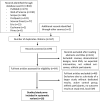Efficacy of Whole-Body Electromyostimulation (WB-EMS) on Body Composition and Muscle Strength in Non-athletic Adults. A Systematic Review and Meta-Analysis
- PMID: 33716787
- PMCID: PMC7952886
- DOI: 10.3389/fphys.2021.640657
Efficacy of Whole-Body Electromyostimulation (WB-EMS) on Body Composition and Muscle Strength in Non-athletic Adults. A Systematic Review and Meta-Analysis
Abstract
This systematic review and meta-analysis set out to determine the efficacy on whole-body electromyostimulation (WB-EMS) on body composition and strength parameters in non-athletic cohorts. A systematic review of the literature according to the PRISMA statement included (a) controlled trials, (b) WB-EMS trials with at least one exercise and one control group, (c) WB-EMS as primary physical intervention, (d) WB-EMS with at least six electrodes covering most muscle groups, (e) non-athletic cohorts. We searched eight electronic databases up to June 30, 2020, without language restrictions. Standardized mean differences (SMD) for muscle mass parameters, total body fat mass, maximum leg extension, and trunk extension strength were defined as outcome measures. In summary, 16 studies with 19 individual WB-EMS groups representing 897 participants were included. Studies vary considerably with respect to age, BMI, and physical conditions. Impulse protocols of the studies were roughly comparable, but training frequency (1-5 sessions/week) and intervention length (6-54 weeks) differed between the studies. SMD average was 1.23 (95%-CI: 0.71-1.76) for muscle mass, 0.98 (0.74-1.22) for maximum leg, and 1.08 (0.78-1.39) for maximum trunk extension strength changes (all p < 0.001). SMD for body fat changes (-0.40, [-0.98 to 0.17]), however, did not reach significance. I 2 and Q-statistics revealed substantial heterogeneity of muscle and fat mass changes between the trials. However, rank and regression tests did not indicate positive evidence for small-study bias and funnel plot asymmetries. This work provided further evidence for significant, large-sized effects of WB-EMS on muscle mass and strength parameters, but not on body fat mass. Clinical Trial Registration: ClinicalTrials.gov, PROSPERO; ID: CRD42020183059.
Keywords: body composition; body fat mass; exercise; lean body mass; muscle strength; whole-body electromyostimulation.
Copyright © 2021 Kemmler, Shojaa, Steele, Berger, Fröhlich, Schoene, von Stengel, Kleinöder and Kohl.
Conflict of interest statement
The authors declare that the research was conducted in the absence of any commercial or financial relationships that could be construed as a potential conflict of interest.
Figures









References
-
- Amaro-Gahete F. J., De-la O. A., Jurado-Fasoli L., Dote-Montero M., Gutierrez A., Ruiz J. R., et al. . (2019a). Changes in physical fitness after 12 weeks of structured concurrent exercise training, high intensity interval training, or whole-body electromyostimulation training in sedentary middle-aged adults: a randomized controlled trial. Front. Physiol. 10:451. 10.3389/fphys.2019.00451 - DOI - PMC - PubMed
-
- Amaro-Gahete F. J., De-la O. A., Sanchez-Delgado G., Robles-Gonzalez L., Jurado-Fasoli L., Ruiz J. R., et al. . (2018a). Functional exercise training and undulating periodization enhances the effect of whole-body electromyostimulation training on running performance. Front. Physiol. 9:720. 10.3389/fphys.2018.00720 - DOI - PMC - PubMed
-
- Aristizabal J. C., Freidenreich D. J., Volk B. M., Kupchak B. R., Saenz C., Maresh C. M., et al. . (2015). Effect of resistance training on resting metabolic rate and its estimation by a dual-energy X-ray absorptiometry metabolic map. Eur. J. Clin. Nutr. 69, 831–836. 10.1038/ejcn.2014.216 - DOI - PubMed
Publication types
LinkOut - more resources
Full Text Sources
Other Literature Sources
Medical

